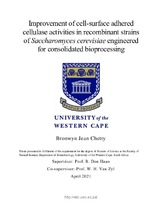| dc.contributor.advisor | Haan, Den. R | |
| dc.contributor.author | Chetty, Bronwyn Jean | |
| dc.date.accessioned | 2021-08-19T07:55:44Z | |
| dc.date.available | 2021-08-19T07:55:44Z | |
| dc.date.issued | 2021 | |
| dc.identifier.uri | http://hdl.handle.net/11394/8357 | |
| dc.description | >Magister Scientiae - MSc | en_US |
| dc.description.abstract | Consolidated bioprocessing (CBP), in which a single organism in a single reactor is responsible for the conversion of pretreated lignocellulosic biomass to bioethanol, remains an attractive option for production of commodity products if an organism fit for this process can be engineered. The yeast Saccharomyces cerevisiae requires engineered cellulolytic activity to enable its use in CBP production of second generation bioethanol. Current recombinant yeast strains engineered for this purpose must overcome the drawback of generally low secretion titres. A promising strategy for directly converting lignocellulose to ethanol is by displaying heterologous cellulolytic enzymes on the cell surface by means of the glycosylphosphatidylinositol (GPI) or similar anchoring systems. Recently, a strain producing cell-adhered enzymes in a ratio-optimized manner was created that showed significant crystalline cellulose hydrolysis. | en_US |
| dc.language.iso | en | en_US |
| dc.publisher | University of Western Cape | en_US |
| dc.subject | Cell-surface | en_US |
| dc.subject | Cellulase activities | en_US |
| dc.subject | Saccharomyces cerevisiae | en_US |
| dc.subject | Bioprocessing | en_US |
| dc.subject | Yeast | en_US |
| dc.title | Improvement of cell-surface adhered cellulase activities in recombinant strains of Saccharomyces cerevisiae engineered for consolidated bioprocessing | en_US |
| dc.rights.holder | University of Western Cape | en_US |

